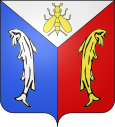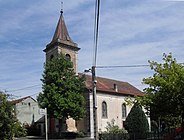Mandeurs
| Mandeurs | ||
|---|---|---|

|
|
|
| region | Bourgogne-Franche-Comté | |
| Department | Doubs | |
| Arrondissement | Montbeliard | |
| Canton | Valentigney | |
| Community association | Pays de Montbéliard agglomeration | |
| Coordinates | 47 ° 27 ' N , 6 ° 48' E | |
| height | 324-581 m | |
| surface | 15.13 km 2 | |
| Residents | 4,819 (January 1, 2017) | |
| Population density | 319 inhabitants / km 2 | |
| Post Code | 25350 | |
| INSEE code | 25367 | |
| Website | www.ville-mandeure.com | |
 Mairie Mandeure |
||
Mandeure is a municipality with 4819 inhabitants (at January 1, 2017) in the department of Doubs in Bourgogne Franche-Comté , one on the border with Switzerland lying region of France . The place is in the Doubs valley , a left tributary of the Saône .
The municipality belongs to the Communauté d'agglomération du Pays de Montbéliard, and thus to the agglomeration of the Belfort and Montbéliard area . Mandeure is the northern starting point of the Grande Traversée du Jura long-distance hiking trail .
history
In Roman times , Mandeure was called Epomanduodurum . It is not certain whether this name comes from the Celtic or the Roman . At that time it was of national importance as a city. The most obvious remains from that time belong to one of the largest Gallo-Roman amphitheaters . Otherwise there were thermal baths and houses .
In the 12th century, the Archbishops of Besançon and the Counts of Mömpelgard divided the area.
On July 25, 1583, the Reformation reached Mandeure. In the following period there was a community of around 300 Catholics as part of the archbishopric and another of around 30 Lutherans under the Prince of Montbéliard (Württemberg) .
The different interests later divide the village into two communities. In 1755 the city's first Lutheran church was built, one of the twenty churches that were rebuilt or renovated on behalf of Duke Karl Eugen during his long reign (1737–1793).
On April 15, 1792, Mandeure became an independent republic with the motto aquila non capit muscas (German: the eagle does not take flies or the eagle does not take flies ). This is still valid today. Shortly thereafter, on October 10, 1793, Mandeure was incorporated into France and from then on belonged to the Doubs department.
In 1844 the small cult room in what is now Rue Charles Goguel was considered too small. The Lutheran parish commissioned Frédéric Morel-Macler to build a new church next to the existing Lutheran cemetery. After completion of the construction work (1845-1848) Pastor Charles Goguel consecrated the new church on October 15, 1848. After damage in the Second World War, the roof and interior were restored and the church reopened on April 25, 1948.
Population development
| year | 1962 | 1968 | 1975 | 1982 | 1990 | 1999 | 2007 | 2016 |
| Residents | 5186 | 5550 | 6596 | 6105 | 5402 | 5142 | 5022 | 4833 |
| Sources: Cassini and INSEE | ||||||||
economy
Peugeot production facilities have existed in the village since the end of the 19th century . Initially, pepper mills and cars were made. The PSA Group now produces the latter in Sochaux or other Peugeot plants, but not in Mandeure. For a long time, until the 1980s, Peugeot manufactured its bicycles or at least some of them in Mandeure . Today only Peugeot Motocycles , a scooter manufacturer , is located in the place .
A paper mill and a company that specializes in corrosion protection also contribute to the town's economy. Mandeure also has a campsite on the banks of the Doubs.
- Churches in Mandeure
literature
- Le Patrimoine des Communes du Doubs. Volume 2, Flohic Editions, Paris 2001, ISBN 2-84234-087-6 , pp. 1289-1296.
Web links
Individual evidence
- ↑ Georges-Frédéric Goguel, Précis historique de la Réformation et des églises protestantes dans l'ancien comté de Montbéliard et ses dépendances , Paris: Marc-Aurel frères, 1841, p. 148.
- ↑ a b c See "Mandeure: l'église luthérienne" , on: Les temples ou églises luthériennes de France , accessed on January 23, 2016.







